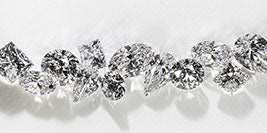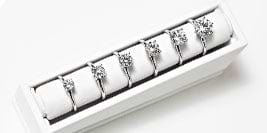Diamonds are amazing. At MiaDonna, we love working with these brilliant gems that sparkle and shine. In this article, we will discuss how fluorescence can affect how a diamond looks to someone looking at it.
Flourescence can cause diamonds to glow under certain lights. However, what echoes through the minds of diamond enthusiasts and prospective shoppers alike is whether fluorescence in a diamond is a desirable trait or an imperfection to be wary of.
Let's examine the enigma of fluorescence and help you understand its effects on a diamond's appearance, value, and appeal. Is it a mesmerizing enhancement that adds a unique dimension to the gem? Or does it shadow the coveted clarity and brilliance that diamonds are celebrated for?
Ultimately: Is diamond fluorescence good, or bad?
What is Diamond Fluorescence?
Diamond fluorescence is a fascinating optical phenomenon that occurs when a diamond emits visible light if exposed to ultraviolet (UV) light. When UV light hits a diamond, it can cast a soft glow in various colors, most commonly blue. This glow is temporary and ceases when the UV light source is removed.
Approximately one-third of diamonds exhibit some degree of fluorescence, which can vary in intensity — ranging from negligible and faint, to bold and vivid. The presence of fluorescence is typically graded on a scale that includes the following categories:
-
None
-
Faint
-
Medium
-
Strong
-
Very Strong
It is also essential to know that diamond fluorescence differs from a diamond's color. Yes, fluorescence can create a visible effect; however, it does not alter the diamond's base color. For instance, a colorless, blue solid fluorescence diamond is still considered colorless when viewed under normal lighting conditions.
The Fluorescence Debate Within the Jewelry Industry
The jewelry industry has passionately debated the impact of diamond fluorescence and its bearing on a stone's beauty and value — and there are a lot of differing opinions. Some experts believe adding a hint of fluorescence to a diamond can make it look whiter and hide imperfections. Still, other professionals express concerns that strong fluorescence might produce a milky or hazy appearance, making the stone less desirable.
The importance of fluorescence in a diamond is subjective and varies based on personal preference and the diamond's unique qualities. As with many aspects of diamonds, personal taste plays a huge role in determining whether fluorescence adds to, or detracts from, a particular gem's overall allure and beauty.
Do All Diamonds Fluoresce?
Simply put, no, not all diamonds fluoresce. About one-third of diamonds glow under UV light, while two-thirds do not. Among those that do, the presence and intensity of diamond fluorescence can vary widely.
Diamonds that do fluoresce can show fluorescence in colors that include blue, yellow, or green when exposed to UV light. Blue fluorescence diamonds are the most common and most desirable, especially in lower-color diamonds.
The presence or absence of fluorescence is just one factor that influences a diamond's overall beauty and value. Other key factors include the 4 C's: a diamond's cut, color, clarity, and carat weight. When considering a diamond for purchase, it is wise to assess the stone as a whole, considering all of these factors rather than focusing solely on fluorescence.
What Scientific Conditions Cause Fluorescence?
Certain elements or structural defects within the diamond crystal primarily influence diamond fluorescence. The essential conditions that contribute to diamond fluorescence include:
-
The presence of boron: Blue fluorescence diamonds are often associated with the presence of boron. When boron atoms are incorporated into the diamond crystal lattice, they can interact with UV light and cause the emission of blue fluorescence.
-
Crystal structure and nitrogen vacancies: The diamond crystal lattice may contain nitrogen atoms or vacancies (missing atoms) within the structure. The interaction between these nitrogen-related defects and UV light can lead to fluorescence, typically in colors other than blue, such as yellow or green.
-
Natural radiation exposure: Diamonds exposed to natural radiation over geological time may develop certain defects or impurities contributing to fluorescence. This radiation exposure is part of a diamond's natural formation process.
-
Intensity of UV light: For fluorescence to be visible, the diamond must be exposed to UV light. The wavelength and strength of the UV light source can influence the fluorescence intensity.
-
Nature of diamond formation: The conditions under which a diamond forms, either naturally or in a controlled lab environment, play a crucial role in diamond fluorescence. Diamonds that form under specific conditions may be more likely to exhibit fluorescence based on the presence of the elements above and defects.
Is There a Diamond Fluorescence Grade?
As we noted, diamond fluorescence is typically graded on a five-category scale. The Gemological Institute of America (GIA), which is one of the leading and most reputable gemological laboratories, uses the following fluorescence grades:
-
None: The diamond shows no fluorescence under UV light.
-
Faint: A small amount of fluorescence is visible but very subtle.
-
Medium: The diamond exhibits moderate fluorescence, which is noticeable but not overpowering.
-
Firm: The fluorescence is readily apparent, even in daylight, and may have a more pronounced impact on the diamond's appearance.
-
Very Strong: The intense fluorescence can significantly affect the diamond's appearance, potentially producing a milky or hazy look.
Is Diamond Fluorescence Visible to the Naked Eye?
In most cases, the everyday diamond shopper may not readily notice the difference between diamonds that fluoresce and those that do not, especially under normal lighting conditions. Fluorescence is typically only visible when a UV light is present. This is not part of the standard lighting environments where a diamond is usually viewed, such as in a jewelry store.
At the same time, diamond graders and trained professionals may evaluate and assess diamonds under controlled conditions using UV light to grade a stone's fluorescence. Again, this is not typically examined during a store's normal diamond-buying process.
Can Lab Grown Diamonds Exhibit Fluorescence?
At MiaDonna, we specialize in Lab Grown Diamonds, and these stones can exhibit fluorescence like their earth-mined counterparts. Fluorescence is a natural phenomenon that can occur in any diamond, regardless of whether it is mined from the earth or created in a controlled laboratory setting. The presence and intensity of fluorescence in lab-grown diamonds are determined by the same factors that influence earth-mined diamonds, such as specific elements or structural anomalies within the diamond crystal.
Like natural diamonds, Lab Created Diamonds can show fluorescence in various colors, with blue fluorescence diamonds being the most common. Furthermore, the impact of fluorescence on a lab-grown diamond's appearance and value is subjective — and comes down to the preferences of an individual diamond shopper.
Suppose you are considering a lab-grown diamond and want to know if it exhibits fluorescence. You can contact the MiaDonna team and check the diamond's grading report, which should provide information about fluorescence, if present. As with any diamond purchase, it is wise to consult with a reputable jeweler or gemologist to understand the characteristics of the diamonds you are interested in and how fluorescence might influence your perception of its beauty.
Additional FAQs About Diamond Fluorescence
As you consider diamond fluorescence and whether you prefer this look in a future diamond purchase, we recommend thinking about the following questions...
Does fluorescence affect fancy-colored diamonds in the same way as colorless diamonds?
Fluorescence in fancy-colored diamonds may have a different impact compared to colorless diamonds. The interaction between the diamond's inherent color and its fluorescence can create unique visual effects, and the influence on the overall appearance can vary.
Can fluorescence be added to a diamond during treatment?
Fluorescence is a natural characteristic of natural and lab-grown diamonds and cannot be added to a diamond through treatment. It's either present or not, based on the diamond's formation conditions. If a diamond is described as having added fluorescence, it may indicate lab-created origin or other treatments.
Can a diamond's fluorescence change over time?
No, a diamond's fluorescence is stable and does not change over time.
Learn More About Diamond Fluorescence: Consult with MiaDonna
Ultimately, beauty is always in the eye of the beholder, and only you can decide if you are interested in a diamond that exhibits fluorescence. The experts at MiaDonna are happy to be your partner in buying the lab-grown diamond of your dreams.
Reach out to us today - we offer Virtual Appointments anywhere in the world, and in-person appointments at our Portland store. We would love to learn about your vision for your dream diamond and will work to ensure your imagination becomes reality.





























